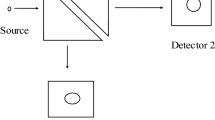Abstract
The concept of complementarity was introduced by William James in 1891, and by physicist Niels Bohr in 1927, the latter probably without knowledge of the former. The phenomena were experienced as “gaps” in thought, and by the experiential observation that thought is divisible into transitive and substantive parts, providing evidence of complementarity. The most obvious phenomenon of psychology, that of thought, therefore requires quantum-theoretical exploration. Bohr was fascinated by the principle of complementarity and of the possibility of a new epistemology based upon it.
Similar content being viewed by others
References
BOHR, NIELS. (1934). Atomic theory and the description of nature. Cambridge: University Press.
BOHR, NIELS. (1950). On the notions of causality and complementarity. Science, 111, 51–54.
HEISENBERG, WERNER. (1958). The representation of nature in contemporary physics. Daedalus, Summer, pp. 103–105.
HOLTON, GERALD. (1973). Thematic origins of scientific thought: Kepler to Einstein. Cambridge: Harvard University Press.
HOLTON, GERALD. (1975). In Owen Gingerich (Ed.), The nature of scientific discovery. Smithsonian Institute Symposium Series. Washington, DC.
JAMES, WILLIAM. (1891). The principles of psychology (Vols. 1–2). London: MacMillan.
KOFFKA, KURT. (1935). Principles of Gestalt Psychology. London: Kegan Paul.
MORISON, S. E. (1942). Admiral of the ocean sea (Vols. 1–2). Boston: Little, Brown & Co.
OPPENHEIMER, J. ROBERT. (1953). Science and common understanding. New York: Simon and Schuster.
SPEARMAN, C. E. (1937). Psychology down the ages. (Vols. 1–2). London: MacMillan.
TARASOV, D. M. (1980). Basic concepts of quantum mechanics. Moscow: MIR Publishers.
TUVE, Merle A. (1967). Physics and the humanities—the verification of complementarity. In C. P. Haskins (Ed.), The search for understanding. Washington, DC: Carnegie Institute.
Author information
Authors and Affiliations
Rights and permissions
About this article
Cite this article
Stephenson, W. William James, Niels Bohr, and Complementarity: I—Concepts. Psychol Rec 36, 519–527 (1986). https://doi.org/10.1007/BF03394970
Published:
Issue Date:
DOI: https://doi.org/10.1007/BF03394970




